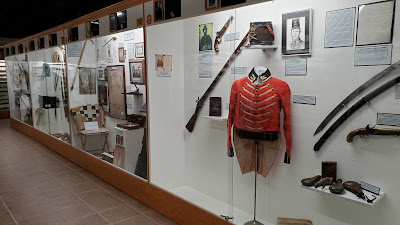Yesterday, my buddy Scott and I played our third Imjin War naval game using David Manley's "At The Height Of Battle" rules. I wasn't going to post a report of the game as the images look pretty much the same as the earlier post of the game. However, because of the author's quick responses to our questions after the game (via the game's FaceBook page), I felt like giving the game another nice shout out.
Maneuvering of fleets during the beginning phases of Turn 2. Korean fleet in the top of the photo. As mentioned previously, each turn has 6 phases (3 per side) that are card driven.
The three Japanese squadrons (lower half of image) having fired heavy artillery (12" range) into the Korean fleet. Heavy artillery fire is tracked using cotton tufts as they can only be fired once per turn. Only two Korean ships were damaged by all of the firing. The overall Japanese commander's ship is the large O Ataka Bune with the center squadron.
Still Turn 2 with two back to back Korean phases (note the cards). Their heavy and light artillery has had greater results on the Japanese ships. For the record, light artillery can be fired during all phases in a turn, but has only a 3" range. The red squares (tokens borrowed from "Roman Seas") indicate damaged ships; red zigzag markers are crippled ships; white smoke, fired heavy artillery, and black smoke, fired piercing arrows - which only the Koreans have, and can only be used once per game.

Korean phase in Turn 3 - this is actually at the end of the turn as the O Ataka Bune command vessel has been captured and 4 Japanese ships already floating wrecks. The Floating Wreck and Crew Tired markers are also from "Roman Seas", the later represent captured ships. The Japanese had captured a Korean ship in an earlier phase, but was re-captured the next phase by Koreans. One of the things clarified by the author after the game, was that captured ships can be immediately crewed by, or set fire to, by the enemy. In our game, my buddy argued that this could only be done in the next phase/turn. Using this "logic" he was able to re-capture his ship in the next phase. I would've attempted to set fire to the captured ship immediately upon capture to have prevented this - this takes a D6 roll of 2-6. Floating wrecks can sink on a roll of 6 during the command phase at the start of each turn. If not, they are subject to drift with the wind direction at the start of the game. I should also note that all of our games have been using movement by oar and not sail. Movement by sail being a bit more complicated because of wind direction, so we've not tried that yet.

Here's a shot with clearer views of the actual ships. The large one in the center is the Japanese command ship, an O Ataka Bune. The smaller ones are Japanese Seki Bune - the majority of the Japanese fleet. The ones they are surrounding for boarding are Korean Panokseon - they mainstay of the Korean fleet. Up to 3 ships can attempt to board one enemy ship. The use of one of the ships boarding factors are used with half of the other two. Prior to boarding, light artillery can used by both sides; also the Japanese can use fire bombs per the rules to lower the abilities of the Koreans. Fire bombs weren't used in this game as we weren't sure if they could be used along with light artillery. This too was clarified by the author after the game - and they can indeed be used with light artillery.

Crew casualties to the O Ataka Bune inflicted during the light artillery exchange prior to boarding dramatically reduced its actual boarding effectiveness. Skulls represent crew casualties - which reduce boarding factors by half. So in the case of the O Ataka Bune, they went from a boarding factor of 7 to 3 - per the rules, always round down. For clarification, factors are added to the die rolls. We place die next to ships that will fire artillery - once fired we place cotton "smoke" if it was heavy artillery fire so we know they can't fire again during the turn.
We called the game as in addition to the capture of the Japanese fleet commander (and his probable immediate execution), four other Japanese ships were floating wrecks and several others damaged. We both thoroughly enjoy the rules, and feel they flow well, and provide a good interpretation for this period.
Apologies for the somewhat lengthy write-up, but wanted to provide more details of the game mechanics. Thanks again for dropping by and wishing you all the best!

















































